Group Swim Etiquette
This is a revised and extended version of an article written 3 years ago. It's reissued today because the Guppy Challenge, which started this week, won't last forever. When it's over, you're out of the nest. As you Guppies join Masters swim groups now, or matriculate to them post-Guppy-Challenge, best if you know the ropes.
If you think single-sporters don't embrace triathletes with big sloppy kisses now, you should've been there in the 1980s! Masters swim teams did not want us in their pools with them, not one little bit (unless the triathlete came from a swim background).
That's why I think it's appropriate to write about group swim etiquette, and I'm talking specifically about Masters swim teams. These team swimmers can feel, to the triathlete, just as insular as (bicycle) roadies, or they can be wide open, all smiles, all-inviting. It depends on the group, depends on the Masters swimmer, depends on the coach.
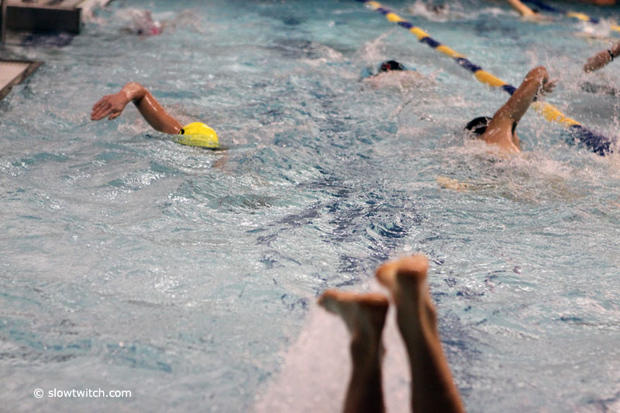
Masters teams are where you get faster. There just is no substitute for them. Triathletes are how many of these teams stay healthy. There are a lot of Masters teams that would be financially limping along today were it not for the influx of triathletes. So, it's wonderfully symbiotic. But there is still the need to infuse yourself into the group seamlessly.
Just know that this is not the place for technique instruction. I've very rarely found Masters teams to be the place for that. You have to get that elsewhere. (Our Reader Forum is the place for that!) Tips on technique from the coach will be irregular, "catch as catch can," as they say (and there's a little pun in there). You might be able to hire that Masters coach for separate one-on-one instruction. But you're not going to get much of that during a Masters workout. My recommendation? Failing anything else? This Slowtwitch Reader Forum thread. Post a video of you there.
Lane organization
Masters teams are organized by lane. Lane 1 is the fastest lane. There will be a "leave" interval that characterizes that lane. A swim "base" means the same thing. It refers to the time it takes you to swim a specific distance plus the rest period before you leave again.
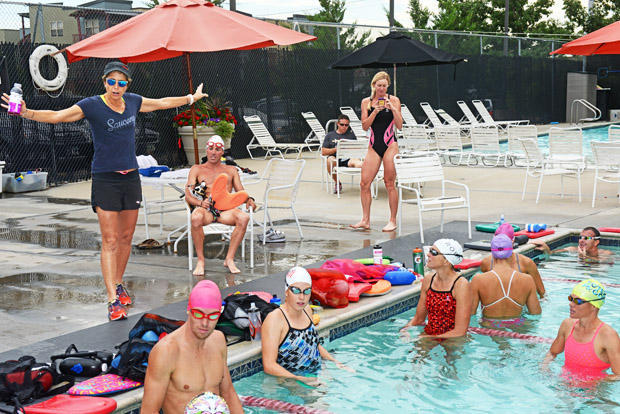
A "set" is a group of swim intervals that all take place start-to-finish. A set might be a bunch of 100-yard repeats, and let's say it's 10 of them, all smooshed together. You might write this as 10×100 and your Masters coach might have a white board with the workout on it and he'll note it this way.
As of this writing exactly half of all Slowtwitchers report that they regularly swim in a 25 yard pool. A third of you swim in 25 meter pools. Ten percent of you swim in 50 meter pools. Most competition pools in the United States are 25 yards long. We call this distance "short course yards" (SCY) and we call it short course because in the winter, and in high school, it's short course season. Long course is 50 meters, and in the Olympics they swim long course. Most 50 meter pools measure 25 yards in width. In the winter it's a lot of lanes going the short way, and often in the summer it's fewer lanes going the long way.
It's pretty rare to see the pool set up long course for Masters swimming because a lot more lanes are available if you set it up short course all the time (even during long course season). By the way, calling it short course yards is not redundant. We add "yards" because, as you see, there are short course meters pools that measure 25 meters long.
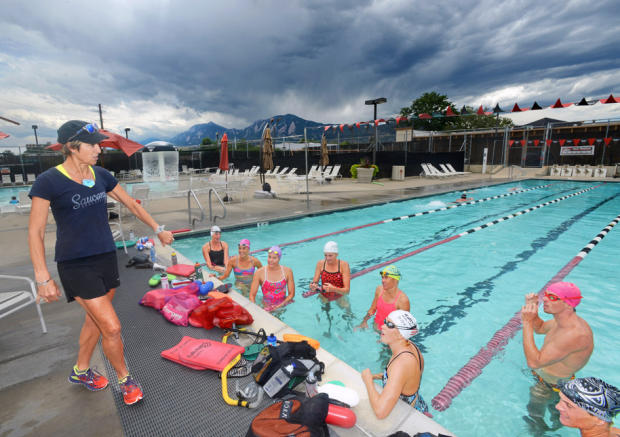
If this is a fast group of swimmers, Lane 1 might repeat on the 1:10 base. That means the 100 yard swim plus the rest equals 1 minute and 10 seconds. When the clock hits 1:10 the swimmer takes off again, on his second 100-yard interval. When the clock hits 2:20 he takes off on his 3rd of 10 eventual 100-yard swims, and then the set is done.
Lane 2 might be the 1:15 lane. Lane 3, 4, 5 and so forth get progressively slower, though there might be a pair of 1:30 lanes, or 1:40 lanes, if the bulk of the swimmers are at that speed.
For those of you who follow the Guppy Challenge (you can begin this at any time), you'll note that I exhort you almost from week-1 to establish and dial in your leave interval. This is, in part, so that when you enter a Masters team you'll have some idea what lane to slot yourself into.
Typically a set will occur at that leave interval regardless of distance. So, if you're in the 1:40 lane and the group performs a set of 12x100yd the group will leave each 1 minute and 40 seconds. If the group swims 6x200yd, the group will typically just double the time, so, every 3 minutes and 20 seconds the group takes off again on the second 200, and the third, until the set is finished.
But this doesn't mean the sets are always performed at that leave interval. It could be that the coach wants you to specifically work on your speed, and that each swim is to be performed at a faster pace, requiring more rest. He also might want you to perform a drill, and the drill means the swim is going to be performed more slowly, requiring a longer time to perform the swim and the recovery. If it's "stroke" day, every stroke but freestyle is either performed more slowly or requires more rest, so, the leave interval is correspondingly slowed on stroke day.
Lane Comportment
It's called "swimming circles." If there are 2 swimmers sharing a lane they might "split the lane," and that means you swim on one side, and I'm on the other. But three's a crowd and at that point everybody swims down the right hand side of the lane, the circle turning clockwise (I am advised that in the UK they circle clockwise). There's a wrinkle to the clockwise/counter-clockwise pattern, explained further below. Yes, it takes a little bit of time to learn not only to flip turn, but to flip turn while pushing off in a slightly different direction than you took when arriving at the wall. But you'll get the hang of it.
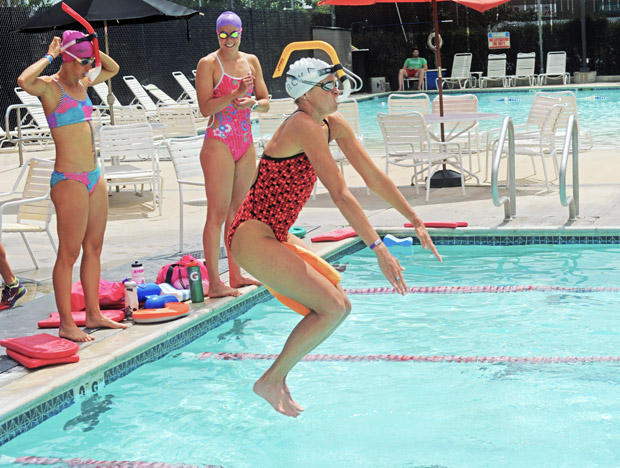
If you don't flip turn, open turns are okay, just know that they take a little longer to perform. Unless everyone in your lane is using open turns, you might want to consider moving toward the back of the lane (if there are 4 people sharing the lane, the back of the lane means you're the caboose).
If somebody is swimming right on my tail, I'll drift over toward the left of the lane just before the wall, so that I have a clear path when I push off the wall. Of course, you can't do that until the person you're following has already pushed off, and there's no one in between you and the wall.
Each person in the lane leaves 5 seconds after the person in front. Leaving "on the top" means leaving on the minute, versus on the :20 or :45 or any other moment around the face of the clock. "On the bottom" means on the :30, when the second hand is at 6 o'clock. Even when the pool is using digital clocks it's often "on the top" or "on the bottom." This just refers to history, when we all had nothing but huge analog pace clocks.
If a set begins, and there are 5 people in the lane, and the lead swimmer leaves on the top, the 2nd in line will leave 5 seconds later, the 3rd in line will leave on the :10, the 4th on the :15, and the last person on the :20. Once everybody comes into the wall at the end of the swim, and the lane leader again embarks, everyone leaves at his or her apportioned 5 second intervals. In theory.
If I were you, and I wanted to observe proper etiquette, I would not cheat on this. But you'll come across plenty of folks who will and this takes us into the tall weeds of Masters etiquette. Why does a person "leave early?" Because he wants to get onto the "feet" in front of him. Swimming right behind someone, in the draft, is worth probably 5 seconds per 100 yards. (Seasoned swimmers wink at each other when a triathlete insists there is no meaningful draft in open water swimming.) If you're a weaker swimmer, you'll need that draft. This is why swimmers cheat on the leave. What should you do if the swimmer in front of you leaves 3 seconds behind the swimmer in front of him? You wait 7 more seconds, and leave when you're supposed to (unless everyone in the lane agrees on a spacing schedule other than 5 seconds, which is very rare in my experience and would only happen if the lane had a ton of people in it).
This is just lane politics. You should just allow early leavers to leave early and not say anything. Early leavers have psychological things going on way down deep, and you're just going to open a huge can of something you don't want any part of if you call an early leaver on his behavior.
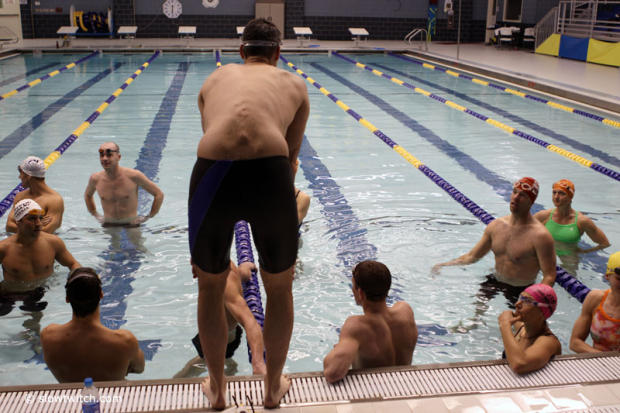
While the lane order is typically fastest-to-slowest, the usual behavior is for the swimmer second in line to motor up the "stagger" within the first 50 yards or so. This means that, while he started 5 seconds behind, he's probably 2 or 3 seconds behind after 50 yards. This is so he can get into the draft of the swimmer in front of him. I'm not saying it should be this way, rather that it often is this way. This means the person swimming 3rd in line has to swim like a sonuvabitch to get on the feet of the guy 2nd in line. And so forth. Unless the guy 4th in line can sprint like a demon he's going to get gapped. Cest la vie. That's Masters swimming.
Sitting out a 50
On sets with long swims, or if there is a lot of people in the lane, you're in danger of getting caught by the lane leader. What do you do? I don't know that there's a specific convention for this. I will pull off tight to the right of the lane, on the wall, making myself small, right on the lane divider, so that the swimmer behind me can pass me by. I won't jump back in until there's an obvious gap between swimmers. That might mean, right there, that there's a new order in the lane. If I'm just gassed I might sit out a 50. By the way, that thing of moving over and making yourself small, that is also the behavior when you finish up any swim. If it's 10×100, there's going to be a crowd of people coming in after every 100 and you need to clear the runway for the next arrival.
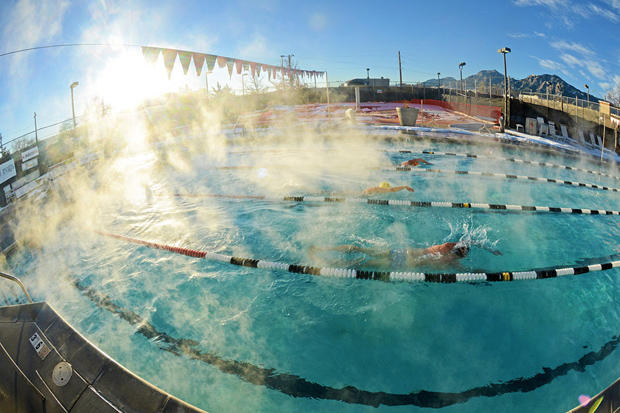
Back to getting lapped, in general I think it's bad pool management for you to have been put in this situation. I would rarely, as a coach, prescribe a set with any swims longer than 200 yards if I had more than 6 people in a lane. Of course it depends on the group. But 6 people in a lane means somebody is leaving 25 seconds after the first swimmer and, depending on the speed of the lane, if I'm the last in the lane that first swimmer is barreling down on me by the time I push off the wall to commence the swim.
Lane Changes
I would always start conservatively in a new group. You're going to be recognized as a faster swimmer than your place in the lane, or in the lane you chose. I would enter a group starting last in a lane I know I can handle (and I'll know that based on that lane's typical leave interval). How fast I make up the 5 second stagger is the body language of the lane. If you're on somebody's feet after that person's first flip turn, 25 yards after the start of an interval, it's not going to take long before that person invites you to move in front of him. How gassed you are during the workout determines whether you accept his invitation, or say, "No thanks, you're doing great, I'm fine where I am."
Just let that process take its natural course. Here's the thing: Don't touch the person's feet in front of you. Yes, that's okay in open water swimming if it occurs rarely. It's really bad form to do that in the pool. Still, if it does happen, that's a signal to the person in front of you to ask you to move up a position.
This thing of lane position, there's a lot of politics going on here. You're going to run into some snappy people from time to time. Just don't react. It never ends well when you do.
Eventually, you might be leading the lane. Great. When do you move up to the next lane? When you think you can handle the quicker interval. When you do move up to the next lane, move to the back, and then the process of lane sorting starts again.
Stroke Day
It's stroke day! Triathletes love stroke day. Not! This is the day when we work on butterfly, backstroke, basically all the stuff you either don't know how to do at all or are conspicuously bad at. What do you do on stroke day? You swim freestyle in every case where you can't swim the stroke. Stroke day is also called IM day, and you might be swimming, say, 8x100yd IM, meaning, fly, back, breast free. What should you do if you don't know how to swim butterfly? Swim free, back, breast, free. Hopefully your first freestyle leg will put you in a good enough spot so that you can afford to lose a little time while performing your crappy backstroke. Then it's breaststroke and anyone with a pulse can muddle through that (though it's a thing of beauty watching a breaststroke specialist at work).
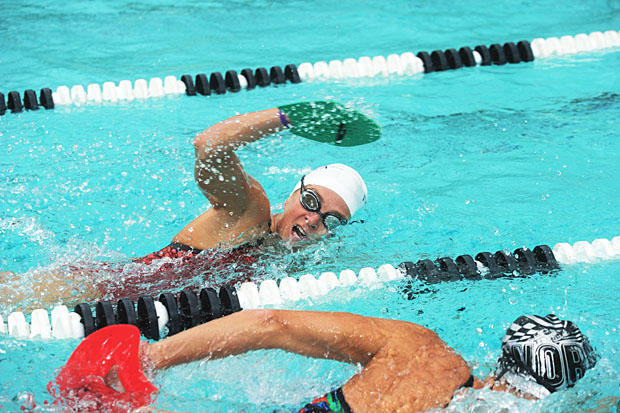
Look, you're just going to have to improvise. Either you just don't show up on stroke day, or you improvise. Nobody is fixated on what you're doing. Just try to be inconspicuous, pacewise. If you're swimming IM sets as freestyle, you're going to go faster than those who're swimming it IM. So, maybe you move to the back of the next lane faster on stroke day.
Kicking
There will be people in the pool who can kick faster than you can swim. What do you do during kick sets? This is the clash between personal optimization versus pool culture. You might feel that you're best off kicking with no fins. But the pace of the lane might require the use of fins so that you don't mess up the rhythm of the lane.
There are plenty of triathletes who are just strong as heck, they're fit, they don't have the pot bellies that middle-aged, swim-culture, Masters swimmers often end up with. So, your fitness, at a certain point, makes up for your lack of technique. Their more moderate fitness is overridden by their excellent technique. Often this means you are the same basic speed as your swim-specialist contemporary. Until it's stroke day. Or, until a kick set. Then you're toast. This is when you might consider a zoomer or even a more aggressive fin, just so that you survive the kick set without throwing the lane into upheaval.
Pulling
It's kind of the same with pulling. Good swimmers almost always pull a lot faster than they swim, that is to say, they swim with hand paddles faster than without hand paddles. A "pull set" means you'll swim with hand paddles and a pull buoy. You (you specifically) might actually swim slower with paddles and a buoy, at least until you're proficient, and that might take quite some time. If you fishtail through the water once you stick a buoy between your thighs, you're going to get the spit kicked out of you by the pure swimmers during every pull set. But, as the Good Book says, "Rejoice! Blessed are you when men shall outkick you, and outpull you…" Especially the outpull part. If you become a fishtailer with a buoy stuck up there, that's a body position problem and fairly easily fixable. You want these kinds of technical deficiencies exposed. (Fishtailers, read all the drills to fix this problem in the ten Guppy Challenge articles.)
But, as to etiquette, I might self-adjust my place in the lane during pull sets. Moving up and down the lane every set is generally not a good thing. But inconveniencing people is worse, if you're just going to slow the lane down because you're such a horrible puller. The alternative is to just not pull during pull sets. Swim during pull sets. But if you swim a pull set realize most of the swimmers behind you are going to speed up once they've got paddles on. This is why I think it's best to move down the lane every time you're faced with a skill you're bad at, then move up the lane when it's back to the freestyle sets.
Somebody else's paddle hurts when you hit it during a swim set (and vice versa). In general it's a good thing to learn not to have a wide arm swing, because you're swimming in the opposite direction of the swimmer in the next lane over, and circle swimming means the two of you are hugging the same lane divider. You're bound to hit hands with your wide arm swing. It's really painful to get smacked with a paddle.
Some Masters groups alternate the circle pattern because of this. Every other lane circles in the other direction. Besides not smacking the paddle on the guy's hand one lane over, it gives you the chance to catch a draft every so often.
In many pools it's considered bad form to hang on the lane divider. But if you're in a Masters workout with more than 4 in a lane, and if the coach is situated on the deep end, you've got nothing else to hang onto. Just, in general, try to be as gentle on the lane dividers as possible.
Some pools are very prickly about taking showers before you get into the pool; others aren't. I'm not going to lecture you on how you should handle pre-swim showers. Just watch what everyone else is doing, and it's probably best not to omit what they're doing. This can be tricky if the pool is outdoors and the air is cold. In this case, a lot of swimmers will come to the pool in their swim parkas (made by Speedo, TYR, etc.). Is taking a shower pre-swim compatible with a swim parka? It's difficult. Just best to watch what others are doing.
In for a landing
So, that's the culture, from my perspective. I love Masters teams. I wish I could swim with them more often but at present there is no Masters team proximate to me. Were there one I would probably swim with it twice a week, because these workouts are too high-intensity for me to swim them daily. But I do remember one year (back in the 1980s) when I was bound and determined to become a front-pack swimmer, or at least somebody who exited a lot higher up than I had been exiting. I swam with a Master's team for 8 solid months, sometimes twice a day. Yes, I rode and ran, but my focus was swimming. This is how you get faster.
Familiarity in the case of Masters does not mean contempt. You'll be invited into the "club" eventually. Just, the invitation might come in stages. It's just like group rides on the bike. The more you show up; and the less conspicuous you are; the more you mold yourself around the group rather than trying to get the group to accommodate you; the faster you'll become one of the group. Then, once in, you might find yourself more in a leadership role, even if it's just leading the lane.
Once a lady came up to me at the Hawaiian Ironman and apologized for what she considered her uppity treatment of me when I, as a triathlete, joined that Masters team I wrote about just above. This was many years after I had moved to a different town and left that team. She had, by that time, won her age group at Kona numerous times. When I swam with her she was just a swimmer, and she admitted that she held triathletes in contempt. Then, somewhere along the way, she decided to try a triathlon, and eventually discovered that swimming was her worst event. God created her a runner, she just (like Mark Allen) didn't know it for the first 2 or 3 decades of her life. So you never know how things will turn out.
I never let the behavior or preconceptions of single-sport specialists toward triathletes bother me. I just figure it's up to me to adopt their single-sport culture when engaging in their group activities. All but the most curmudgeonly will appreciate the effort. It's like trying to speak your bad Spanish when traveling to Mexico. It's not the quality of your Spanish, it's the effort you're making that's appreciated. Masters swimming is your ticket to a faster, safer swim experience in the open water, even though Masters workouts do not take place in the open water. Taking the plunge might seem a little daunting but, take this data point for what it's worth, I cannot think of a top triathlete who does not swim Masters or, if not, that athlete swims on a high-level tri team that replicates masters (some of the images above are of Siri Lindley's enclave of pro triathletes she coaches).


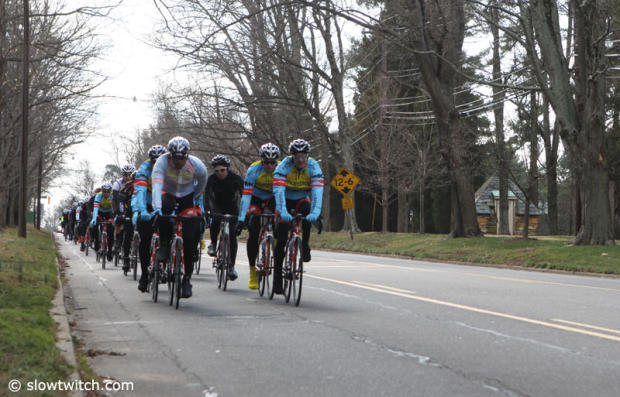


Start the discussion at slowtwitch.northend.network